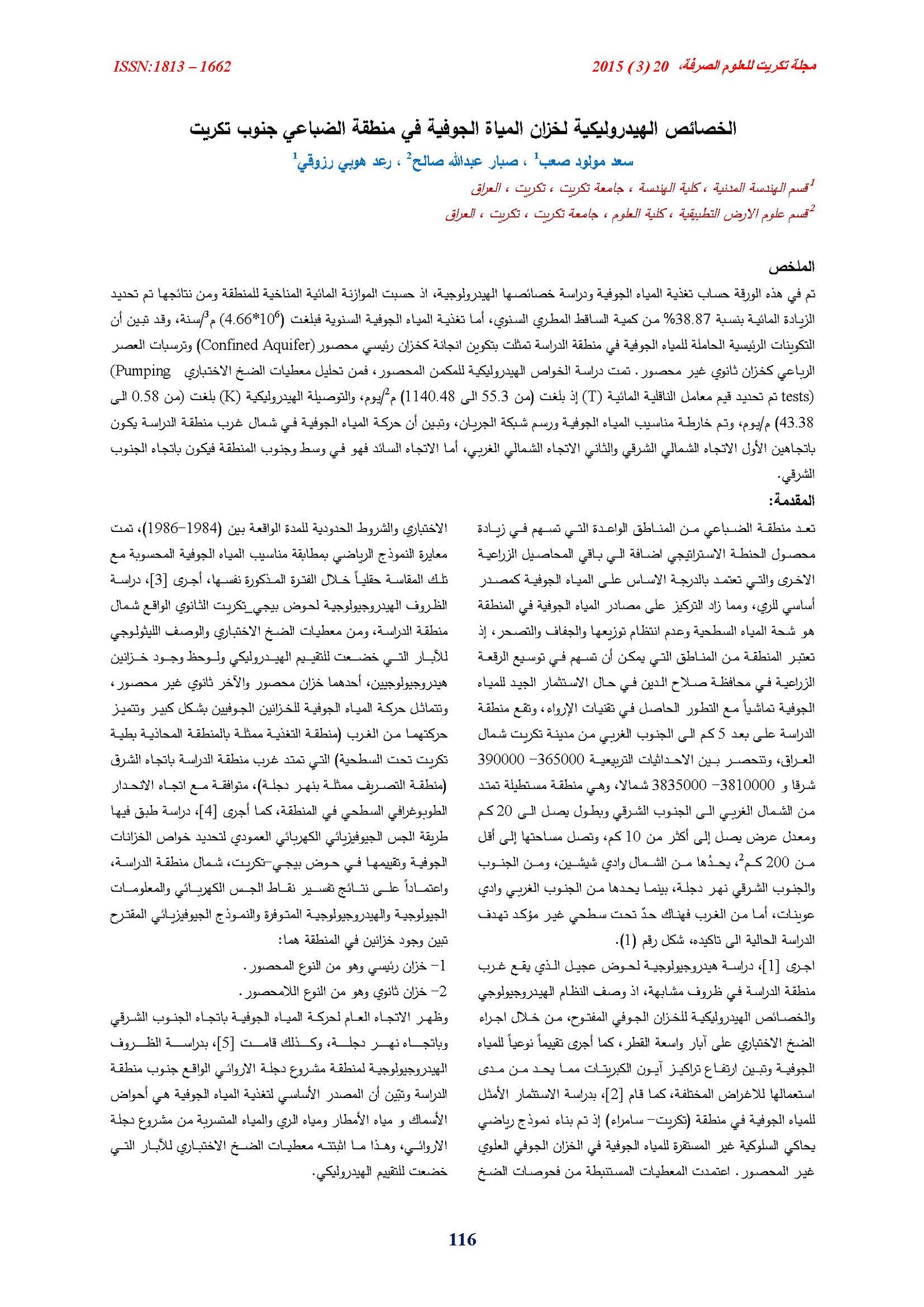Hydraulic characteristics of the groundwater aquifer in Al-Dhibaei Area South Tikrit
Main Article Content
Abstract
In this study the ground water recharge was estimated, with studying the hydrological conditions Al-Dhubaei region which located 5 km to the southwest of Tikrit city. Depending on the data of Tikrit meteorological station, the averages monthly climatic elements (rainfall, temperature and evaporation) were studied for a period of (1989-2013), the average annual rainfall reached 166.72 mm, as well as the evaporation-transpiration rates were calculated using Thornthwait method. The water balance of the area was calculated and the results show that the ratio of water surplus were reached to 38.87% of the total annual rainfall, and the groundwater recharge equal to 4.66×106 m3/year.
Also, the hydrogeological study of the region show that the main bearing formations of groundwater represented by Injana formation and Quaternary deposits, which are Confined Aquifers, the hydraulic properties were studied, and pumping test data show that the Transmissibility (T) ranged between (55.3 to 1140.48) m2/day, while the Hydraulic Conductivity (K) ranged between (0.58 to 43.38) m/day. The ground water table map and flow net were drawn, and show that the flow in northwest of the study area takes two trends, to the northeast and to the northwest, but in the middle and south of the area the flow was to the southeast.
Article Details

This work is licensed under a Creative Commons Attribution 4.0 International License.
Tikrit Journal of Pure Science is licensed under the Creative Commons Attribution 4.0 International License, which allows users to copy, create extracts, abstracts, and new works from the article, alter and revise the article, and make commercial use of the article (including reuse and/or resale of the article by commercial entities), provided the user gives appropriate credit (with a link to the formal publication through the relevant DOI), provides a link to the license, indicates if changes were made, and the licensor is not represented as endorsing the use made of the work. The authors hold the copyright for their published work on the Tikrit J. Pure Sci. website, while Tikrit J. Pure Sci. is responsible for appreciate citation of their work, which is released under CC-BY-4.0, enabling the unrestricted use, distribution, and reproduction of an article in any medium, provided that the original work is properly cited.
References
[6]-Fouad, S.F., (2010): Tectonic Map of Iraq, scale 1:1000 000, 3rd edit. GEOSURV, Baghdad, Iraq.
[7]-Buday, T. and Jassim, S.Z., (1987): Tectonic Map of Iraq, Scale1:10000000, GEOSURV, Baghdad, Iraq.
[8]-Ditmar, V., (1971): Geological Conditions and Hydrocarbon Prospects of Republic of Iraq (North and Central parts), rept. no. 552.
[9]-Hamza, N.M. and et al., (1990): Project C.E.S.A. Geological Activity, Regional geological stage project, GEOSURV, int .rep. no. 2023.
[10]-Al-Kadhimi, J.A., Dawood, Y.N., Abdul-Sattar, M., Ali, H.A. and Kamil, J., (1990): Local Geophysical Stage Report, Vol.3: Refraction Seismic Method Complex Geophysical Well Logging Methods, contract of the earth sciences actives. GEOSURV, int. rep. no. 2019.
[13]-Hawkins, R. H., (2004): National Engineering Handbook, United States Department of Agriculture Natural Resources Conservation Service, 791P.
[14]-Sanders, L.L., (1998): A manual of Field Hydrogeology, Prentice-Hall, p. 381.
[15]-Raghunath, H. M., (2006): Hydrology, principles, analysis and design, New Age International Publisher, 2nd ed., New Delhi, India, 463P.
